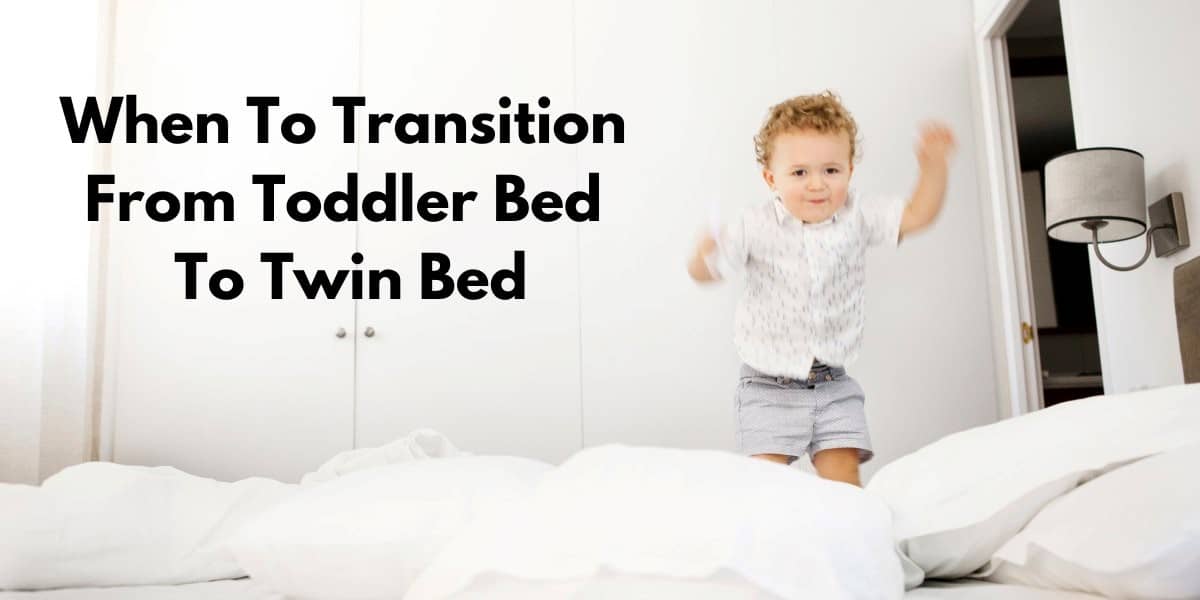Are you a parent wondering when is the right time to transition your child from a toddler bed to a twin bed? It’s a common question that many parents face as their little ones continue to grow. In this article, we will explore this topic and provide you with some valuable insights.
We’ll discuss the factors to consider, signs that your child is ready, and tips for a smooth transition. By the end, you’ll have a better understanding of when it might be time to make the switch and how to make it a positive experience for your child. So let’s get started!
Signs That Your Child is Ready for a Twin Bed
Physical Readiness
One of the first signs that your child may be ready for a twin bed is their physical readiness. Take note of their height and weight. If your child has outgrown their toddler bed and their feet are hanging off the end, it may be time to transition to a larger bed. A twin bed will provide them with more space to stretch out and sleep comfortably throughout the night.
Cognitive Readiness
Cognitive readiness or Cognitive Development is another important factor to consider. Is your child able to understand the concept of a larger bed? Are they able to follow simple instructions and stay in bed without constantly getting up? If your child is consistently able to stay in their toddler bed and demonstrates an understanding of sleep routines and expectations, they may be mentally prepared for a twin bed.
Emotional Readiness
Emotional readiness is crucial when it comes to transitioning to a twin bed. Pay attention to your child’s reactions when discussing the idea of a new bed or when visiting friends or family who have twin beds. If your child expresses excitement or shows an interest in having their own big kid bed, it may be a good indication that they are emotionally ready for the transition. However, if they seem hesitant or anxious about the change, it may be best to wait a little longer until they feel more comfortable.
Also Check: How To Teach A Toddler To Blow Their Nose?
Factors to Consider Before Transitioning
Age
While age is not the sole determining factor, it is important to consider your child’s age when considering the transition to a twin bed. Most children make the switch between the ages of 2 and 4, but every child develops at their own pace. Some children may be ready earlier, while others may need more time in their toddler beds. It’s crucial to evaluate your child’s physical and emotional readiness rather than solely relying on their age.
Size and Weight
The size and weight of your child are important considerations before transitioning to a twin bed. Ensure that your child has enough space to comfortably sleep and move around in a twin bed. If your child is particularly tall or heavy for their age, it may be necessary to consider a larger bed, such as a full-size or queen-size, to accommodate their needs. Your child’s safety and comfort should always be a top priority.
Physical Abilities
Take into account your child’s physical abilities when deciding on a twin bed. Are they able to climb in and out of their toddler bed without assistance? Can they easily get on and off the twin bed without difficulty? Consider the height of the bed and the presence of any steps or guardrails to ensure that your child can safely navigate their new sleeping arrangement.

Preparing Your Child for the Transition
Communication
Effective communication is key when preparing your child for the transition to a twin bed. Talk to your child about the upcoming change and explain the benefits of having a bigger bed. Address any concerns or fears they may have and reassure them that you will be there to support them throughout the process. Encourage them to ask questions and involve them in the decision-making process whenever possible.
Involvement
Involving your child in the transition process can help them feel more empowered and excited about the change. Take them shopping with you to pick out their new bedding or allow them to choose a new stuffed animal or nightlight for their new bed. Letting them have a say in the decision-making will make them feel more involved and invested in the transition.
Bedtime Routine Changes
Transitioning to a twin bed may require some adjustments to your child’s bedtime routine. If your child has been accustomed to being in a crib or toddler bed, they may need extra support during the transition. Consider implementing a consistent bedtime routine that includes reading a bedtime story, practicing relaxation techniques, or providing a transitional object, such as a special blanket or stuffed animal. These small changes can help your child feel secure and promote a smooth transition to the twin bed.
Choosing the Right Twin Bed
Mattress Quality
Choosing the right mattress for your child’s twin bed is crucial for their comfort and support. Look for a mattress that is firm enough to provide proper spinal alignment, yet comfortable enough for a good night’s sleep. Consider factors such as mattress material, thickness, and overall quality. It’s important to prioritize your child’s sleeping needs over aesthetic preferences when selecting a mattress.
Safety Features
The safety of your child should always be a top priority when choosing a twin bed. Look for beds with sturdy construction and guardrails to prevent falls during the night. Ensure that the bed meets safety standards and has no potential hazards, such as sharp edges or loose parts. By selecting a bed with appropriate safety features, you can have peace of mind knowing that your child is sleeping in a secure environment.
Design and Theme
While not as important as mattress quality and safety features, the design and theme of the twin bed can add an element of excitement and personalization to the transition. Involve your child in the process of selecting a bed that reflects their interests and personality. Whether they prefer a princess-themed bed or a bed adorned with their favorite superhero, choosing a twin bed that resonates with your child can make the transition more enjoyable for them.
Tips for a Smooth Transition
Make it Exciting
Transitioning to a twin bed should be an exciting milestone for your child. Make the process feel special by celebrating the occasion. Consider hosting a “big kid bed” party or allowing your child to invite a friend over to spend the night in their new bed. Creating positive associations with the transition can help to alleviate any anxieties your child may have.
Gradual Transition
Some children may feel more comfortable with a gradual transition from their toddler bed to a twin bed. Start by introducing the twin bed as a naptime spot or as an alternative sleeping option alongside their toddler bed. As your child becomes more acclimated to the twin bed, gradually phase out the use of the toddler bed. This approach allows your child to adjust at their own pace and minimizes the potential for resistance or sleep disruptions.
Ensure Safety
Safety should always be a top priority during the transition period. Ensure that the twin bed is placed in a safe location in the room, away from windows, furniture edges, and other potential hazards. Install bed rails on the sides of the twin bed to prevent falls, especially in the early stages of the transition. Additionally, reinforce safe sleep practices by using appropriate bedding, such as fitted sheets and lightweight blankets or sleep sacks.
Frequently Asked Questions FAQs
Will it disrupt my child’s sleep?
Transitioning to a twin bed can initially cause some disruptions to your child’s sleep routine. They may feel a bit unsettled or unfamiliar with the new sleeping arrangement. However, with time and consistency, most children adapt well to the change. Reassure your child and stick to their established bedtime routine to help them feel secure and promote healthy sleep habits.
What if my child falls off the bed?
To minimize the risk of falls, consider using bedrails or placing the twin bed against a wall. Lower the height of the bed to make it easier for your child to climb in and out safely. Additionally, make sure the surrounding area is clear of any sharp objects or furniture corners that could cause injury if a fall occurs. If you’re concerned about your child falling off the bed, consider placing a soft mattress or pillows on the floor next to the bed as an extra precaution.
Should I involve my child in choosing the new bed?
Involving your child in choosing the new bed can be a great way to empower them and make them excited about the transition. By allowing them to have a say in the decision-making process, they will feel more invested and comfortable in their new sleeping arrangement. Consider narrowing down the options to a selection of beds that meet your criteria and let your child choose their favorite.
How long does the transition process usually take?
The transition process can vary from child to child. Some children adapt quickly and seamlessly to the twin bed, while others may take longer to feel fully comfortable. It’s important to be patient and allow your child to adjust at their own pace. With consistency and a supportive approach, most children settle into their new bed within a few weeks to a few months.
Conclusion
Transitioning from a toddler bed to a twin bed is an exciting milestone in your child’s development. By paying attention to their physical, cognitive, and emotional readiness, you can determine when the time is right for this important transition. Consider factors such as age, size, weight, and physical abilities before selecting the right twin bed for your child.
Preparing your child for the transition through effective communication, involvement, and bedtime routine changes can help make the process smoother. Finally, address any common concerns or FAQs to alleviate any anxieties and ensure a successful transition. Remember, the key is to prioritize your child’s comfort, safety, and happiness throughout the entire process.

